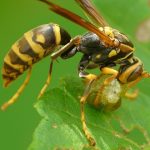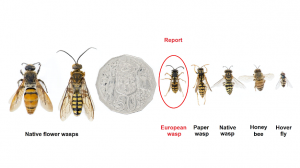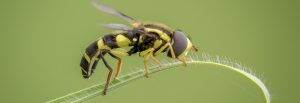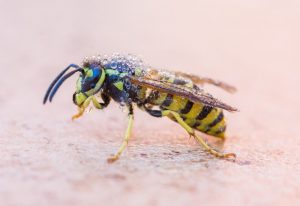
Wasps
There are over 12,000 species of wasps in Australia ranging from the tiny diapriid wasps, which are barely visible to the naked eye, to the spider wasps and cicada-killer wasps, capable of taking down large prey. Wasps are well known for their aggressive behaviour and painful sting. Unlike bees, they can sting multiple times and also leave a pheromone on their victim that attracts other wasps.
They are most likely to attack when their nest is disturbed. A social wasp in distress emits a pheromone that sends nearby colony members into a defensive, stinging frenzy. Along with the painful sting, many people are also allergic to them. Ten percent of the population are allergic and this poses a high risk when stings occur around the throat or face in particular.
EPC – Enviro Pest Control’s fully trained staff provide a wasp removal service in Melbourne to eliminate wasps and their nests. When getting rid of wasps, we cover up with specialised clothing, as the chance of being attacked while removing a nest is high. Doing it yourself is risky, so why not contact us and save yourself the pain.

Wasps in Melbourne
The most commonly found wasp in Melbourne is the European Wasp. The European wasp is an introduced species and therefore doesn’t have natural predators in Australia to keep its numbers in check. It is far more aggressive than native wasps.
- European Wasp (vespula germanica)
- Introduced, non-native species
- 12-17mm long
- Bright yellow with a black banded abdomen with a pair of black spots on each yellow band
- Yellow legs
- Aggressive multiple stinger
- Common Wasp (vespula vulgaris)

- 12-16mm long
- Aggressive
- Have black antennae & fly with legs close to their body
- Yellow Jackets (Social Wasp)
- 13-15mm long
- Alternating black & yellow bands
- Eat other insects as well as human food
- Repeat stingers when provoked
- Native Paper Wasp (polistes humilis)
- 10-22mm long
- Slender body with very narrow waist, small head
- Abdomen has some yellow/orange bands but is mainly black
- Brown tinted wings
- Mud Nesting Wasps (various species -Vespidae and Sphecidae)
- 5-30mm long
- Colour ranges from orange & black to yellow & black
- Solitary wasps
- Non aggressive
- The slender Mud Dauber and some others are often wrongly identified as hornets
- Sand Wasp (bembix sp.)
- 22mml long
- Can be yellow & black or white & black with bands. Many have pale greenish markings
- Feed on nectar & hunt other insects for their larvae
- Non-aggressive but if nest is threatened will attack in a swarm
- White-faced Brown Paper Wasp (ropalidia plebeian)
- 0.8-10mm long
- White face & red/brown body with rings in white around throat & abdomen
- Known pollinators
- Usually nest under overhangs
- Tree Brown Paper Wasp (Ropalidia socialistica)
- 08-12mm long
- Yellow body with brown markings
- Usually nest on sides of buildings & inside hollow trees
Getting Rid Of Wasps
Because of the aggressive nature of wasps, getting rid of them is usually something clients want to do fast. It is important to get rid of the wasps’ nest. As angry as they may appear when provoked, wasps usually only attack when they feel disturbed or threatened. The best thing to do is leave the wasps nest alone and wait until one of our technicians arrives. Prior to your service ensure people and pets are kept away for the nest or activity.
If someone has been stung by wasps, then it is important to monitor the bites for signs of allergic reactions. This can include swelling, dizziness, hives, bite marks getting larger, or extreme itchiness and other more serious signals.
Discourage Wasps
- Do not leave fallen fruit or food scraps lying around the yard
- Avoid leaving uneaten pet food or dog bones outside
- Make sure rubbish bins have tight fitting lids
- Keep compost covered at all times
- Keep swimming pools covered when not in use
- Cover exposed food at picnics and barbeques
- Don’t drink out of cans or bottles, use clear containers or a straw.
Breeding and Life Cycle of Wasps
Each nest usually lasts one year but in warmer climates the nest may survive and expand.
Most wasps have carnivorous larvae that feed on other insects and spiders. The adults provide food for them by capturing prey or by laying the egg on or near the food source, which might be an egg, larva or pupa of another insect.
Signs of Wasp presence
Wasps often build nests close to where humans live or work. They are commonly found in walls or roof voids of houses, garden retaining walls, firewood piles and various outdoor areas. The constant coming and going of wasps to a nest usually makes them relatively easy to find. Look for:
- Live or dead insects
- Nests – In trees, under the eaves, roof voids, sheds, bushes etc.
- Noise – constant humming or buzzing
Wasp nests most commonly found in Melbourne by EPC – Enviro Pest Control;
- Ground Nests- These types of nests house ground-digging wasps. They are commonly found around homes, and business buildings and the females are known to sting when provoked.
- Paper Nests- The most common type found in Melbourne by EPC are European Paper Wasp and Asian Giant Hornet. Their nests are found nearby gutters of homes or business buildings, on the steps of a porch or hanging from a tree branch. The cells of these nests are often hexagonal in shape.
- Mud Daubers- Their nests are made from mud. Mud daubers are typically considered as a nuisance and not as a threat to humans due to being known for rarely stinging people; however, it is still essential to get control and removal services done.
EPC’s Fun facts about Wasps
- A Wasp nest weighing nearly 100 kilograms was found on a Tasmanian farm in 2015!
- Wasps cannot see the colour red
- Wasps live everywhere except Antarctica
Why Hire EPC – Enviro Pest Control To Remove your Wasps?
At EPC – Enviro Pest Control we have a lot of experience when it comes to wasp removal in Melbourne. If you notice that the number of wasps you see is increasing, there is a chance that there might be a nest around or in your property. To eliminate the risk of yourself, your children or pets being stung, EPC need to inspect your home or inspect your business building and treat the infestation to a control and eliminate to infestation. EPC’s staff are well trained and will ensure that nobody is at risk of being stung before beginning the removal process. Other reasons to hire EPC – Enviro Pest Control as your wasp removal service are:
- EPC – Enviro Pest Control staff are trained and experienced pest controllers
- Fast, reliable service
- Professionally dressed staff
- We arrive on time
- Fairly priced and high quality
- Use the right chemicals for the job
If you need to speak to a professional about wasp removal in Melbourne, call 03 9988 5066 now.
